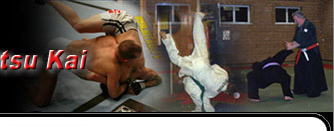|
Groundwork
Principles - Obviously the aim is to gain a submission,
but 90% of your groundwork fighting will be to gain control of your
opponent first. Without being in control you cannot achieve a submission.
Once you have control you should then work towards a more advantageous
position/control until you are able to attempt a submission with
little risk of losing this control.
8th
Kyu - Red Belt
As explained earlier the basis of groundwork is gaining control
and then moving into a better control position, so right from the
start each grade has a transition from one control position to another.
Starting with a simple switch of the base. There are also 2 simple
submissions that are widely used in groundwork.
7th
Kyu - Yellow Belt & 6th Kyu - Orange Belt
Again 2 simple transitions from one control to another. Along with
some basic but fundamental points for being on the ground.
5th
Kyu - Green Belt
If someone has mounted you, you are in a very vulnerable position,
so you need to know how to escape; and without making the situation
worse. There are 2 questions on your knowledge about why we do certain
things.
4th
Kyu - Purple Belt
First of the transitions into the front mount position (one of the
most advantageous positions to aim for). Then you will be asked
to demonstrate a submission from the front (and rear) mount.
3rd
Kyu - Blue Belt
Another transition into the mount - this time involving slightly
more movement.
2nd
Kyu - Brown Belt
Again, another transition into the mount - this time involving the
greatest amount of movement.
The guard is a very good defensive position that you will find yourself
in often, (especially if against a much bigger/stronger opponent)
- however it can also be good for attacking, so here you will be
asked to demonstrate submissions from the guard.
1st
Kyu - Brown Belt, one red tag
General submissions are asked for here. (Be careful with the heel
hook as they are very dangerous.)
Groundwork sparring is asked for at this level - all we want to
see is that you have an understanding of the principles of groundwork
and are looking to move in the right direction before attempting
submissions.
Other
Points for Groundwork
Why
do we need to learn groundwork?
Being on the ground is often the worst place to be in a self defense
situation - friends of the attacker or any other 'standers by' might
decide to join in, and being on their feet can do you a great deal
of harm if you are on the floor. For this reason NEVER purposely
take a self defense situation to the ground.
However, unfortunately
in most scenarios a self defense situation will end up going to
the ground whether you intend it to or not. In which case you need
to be able to deal with it.
Why
do we practice against resisting opponents when an attacker would
be untrained?
We practice techniques that would be against an UNTRAINED attacker,
however it takes a higher degree of skill to beat someone who knows
what you are doing and is not only resisting you but also trying
to submit you. Then with this higher skill level you will find it
very easy against someone who is untrained.
Also as your opponents
improve and give you a harder time, your ability will also need
to improve to beat them - as a result everyone training within the
club will help each other to become very strong at groundwork.
|





